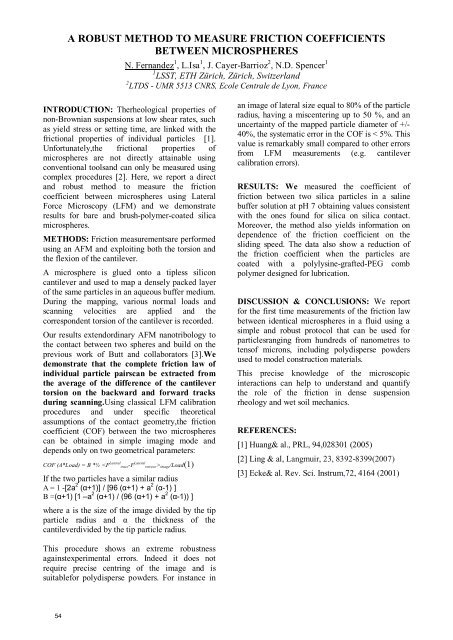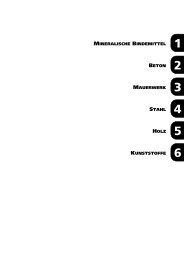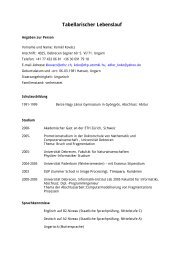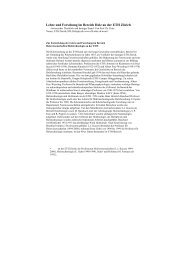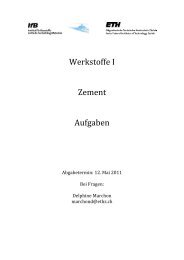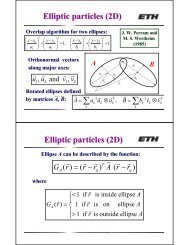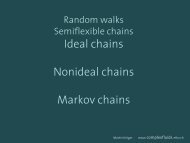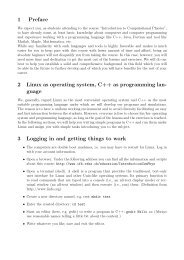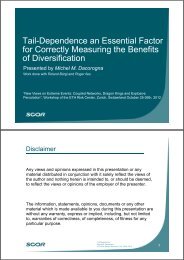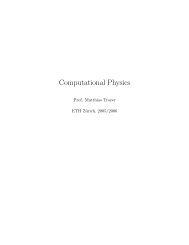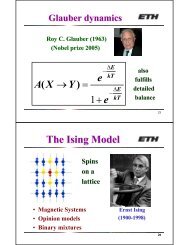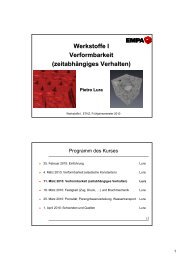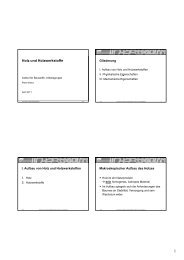Here - Institute for Building Materials - ETH Zürich
Here - Institute for Building Materials - ETH Zürich
Here - Institute for Building Materials - ETH Zürich
Create successful ePaper yourself
Turn your PDF publications into a flip-book with our unique Google optimized e-Paper software.
A ROBUST M<strong>ETH</strong>OD TO MEASURE FRICTION COEFFICIENTSBETWEEN MICROSPHERESN. Fernandez1 , L.Isa 1 , J. Cayer-Barrioz 2 , N.D. Spencer 11 LSST, <strong>ETH</strong> Zürich, Zürich, Switzerland2 LTDS - UMR 5513 CNRS, Ecole Centrale de Lyon, FranceINTRODUCTION: Therheological properties ofnon-Brownian suspensions at low shear rates, suchas yield stress or setting time, are linked with thefrictional properties of individual particles [1].Un<strong>for</strong>tunately,the frictional properties ofmicrospheres are not directly attainable usingconventional toolsand can only be measured usingcomplex procedures [2]. <strong>Here</strong>, we report a directand robust method to measure the frictioncoefficient between microspheres using LateralForce Microscopy (LFM) and we demonstrateresults <strong>for</strong> bare and brush-polymer-coated silicamicrospheres.M<strong>ETH</strong>ODS: Friction measurementsare per<strong>for</strong>medusing an AFM and exploiting both the torsion andthe flexion of the cantilever.A microsphere is glued onto a tipless siliconcantilever and used to map a densely packed layerof the same particles in an aqueous buffer medium.During the mapping, various normal loads andscanning velocities are applied and thecorrespondent torsion of the cantilever is recorded.Our results extendordinary AFM nanotribology tothe contact between two spheres and build on theprevious work of Butt and collaborators [3].Wedemonstrate that the complete friction law ofindividual particle pairscan be extracted fromthe average of the difference of the cantilevertorsion on the backward and <strong>for</strong>ward tracksduring scanning.Using classical LFM calibrationprocedures and under specific theoreticalassumptions of the contact geometry,the frictioncoefficient (COF) between the two microspherescan be obtained in simple imaging mode anddepends only on two geometrical parameters:COF (A*Load) = B *½ image /Load(1)If the two particles have a similar radiusA = 1 -[2a 2 (α+1)] / [96 (α+1) + a 2 (α-1) ]B =(α+1) [1 –a 2 (α+1) / (96 (α+1) + a 2 (α-1)) ]where a is the size of the image divided by the tipparticle radius and α the thickness of thecantileverdivided by the tip particle radius.an image of lateral size equal to 80% of the particleradius, having a miscentering up to 50 %, and anuncertainty of the mapped particle diameter of +/-40%, the systematic error in the COF is < 5%. Thisvalue is remarkably small compared to other errorsfrom LFM measurements (e.g. cantilevercalibration errors).RESULTS: We measured the coefficient offriction between two silica particles in a salinebuffer solution at pH 7 obtaining values consistentwith the ones found <strong>for</strong> silica on silica contact.Moreover, the method also yields in<strong>for</strong>mation ondependence of the friction coefficient on thesliding speed. The data also show a reduction ofthe friction coefficient when the particles arecoated with a polylysine-grafted-PEG combpolymer designed <strong>for</strong> lubrication.DISCUSSION & CONCLUSIONS: We report<strong>for</strong> the first time measurements of the friction lawbetween identical microspheres in a fluid using asimple and robust protocol that can be used <strong>for</strong>particlesranging from hundreds of nanometres totensof microns, including polydisperse powdersused to model construction materials.This precise knowledge of the microscopicinteractions can help to understand and quantifythe role of the friction in dense suspensionrheology and wet soil mechanics.REFERENCES:[1] Huang& al., PRL, 94,028301 (2005)[2] Ling & al, Langmuir, 23, 8392-8399(2007)[3] Ecke& al. Rev. Sci. Instrum,72, 4164 (2001)This procedure shows an extreme robustnessagainstexperimental errors. Indeed it does notrequire precise centring of the image and issuitable<strong>for</strong> polydisperse powders. For instance in54


